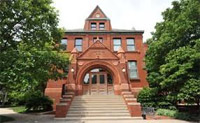Architecture, College of

Masters in Architecture Program: Theses
First Advisor
Mark Hinchman
Date of this Version
5-2021
Document Type
Thesis
Citation
A thesis presented to the faculty of the Graduate College at the University of Nebraska in partial fulfillment of requirements for the degree of Master of Science
Major: Architecture
Under the supervision of Professor Mark Hinchman
Lincoln, Nebraska, May 2021
Abstract
Julia Morgan (1872-1957) was the first female registered architect in the state of California (1902). Despite her prolific independent practice, recognition for her work came late even for her most known project, Hearst’s Castle in San Simeon, California.
Throughout history, women have been repeatedly left out of the history of architecture and design, often being overshadowed by their male partners. This paper will seek to clarify reasons to decipher why this particular architect was left out of history and the media during her lifetime and will show that her omissions were not solely due to the fact that she was a woman in man’s field in the early part of the 20th century.
A qualitative study using a historical research method was utilized to evaluate historical happenings and trends to find the facts to analyze and interpret recurring themes. Literature reviewed was scholarly journals, newspaper articles, magazine articles, and books written both concurrently and after this particular time in history. Great attention was paid to contemporary and past newspaper, magazine, and other literature coverage in order to conduct proper research.
By collecting information through content analysis, a conclusion was made based on the role of a woman architect at this particular time in history as compared to her male contemporaries, the specific client/architect relationship of San Simeon concentrating on their specific personalities, the presence of Morgan’s gendered characteristics and their role in her career, and the negative portrayal of W.R. Hearst and the San Simeon Castle in the media. While focusing on how the San Simeon project was overshadowed by these topics and the emerging focus on Modernism, this work will show that factors such as these contributed to why Julia Morgan did not get the notoriety she deserved as an architect other than reason pertaining solely to gender.
The information will be useful to historians of architecture and design as well as researchers in women’s studies to understand this phenomenon. The theory present is that there were many factors involving the state of the particular architectural project, the persons involved, and the architectural field itself at the beginning of the twentieth century that added to her omissions in literature.
Advisor: Mark Hinchman
Included in
Architectural History and Criticism Commons, Other American Studies Commons, Women's Studies Commons


Comments
Copyright 2021, Renee Meyer